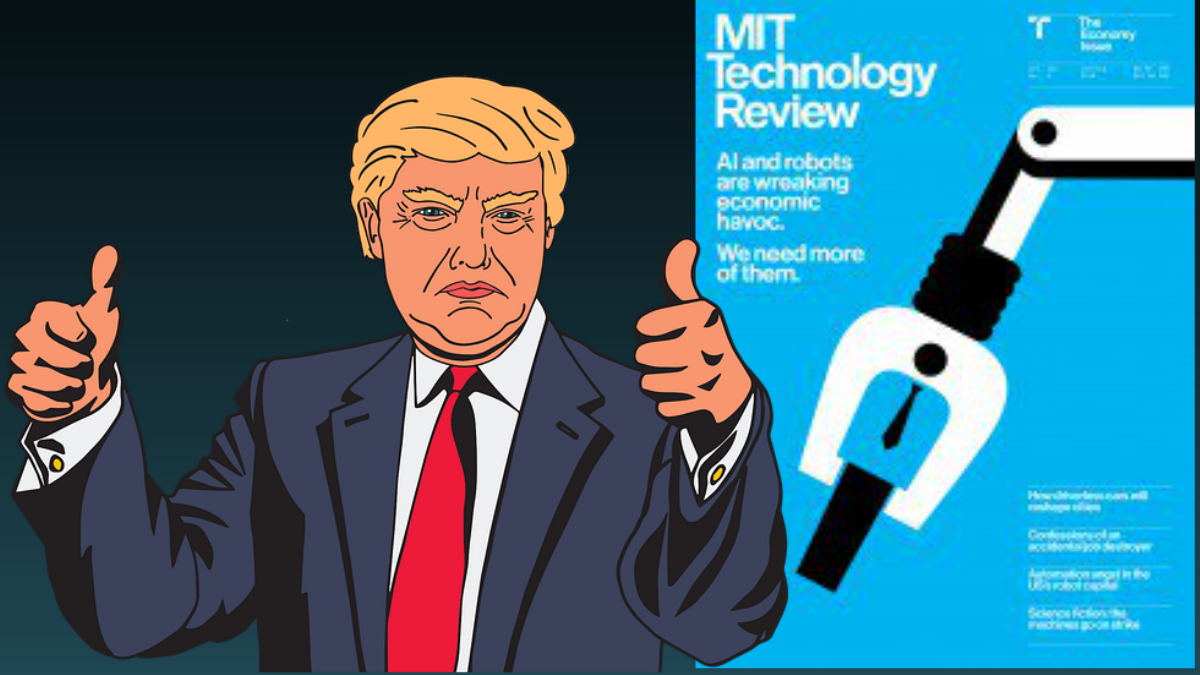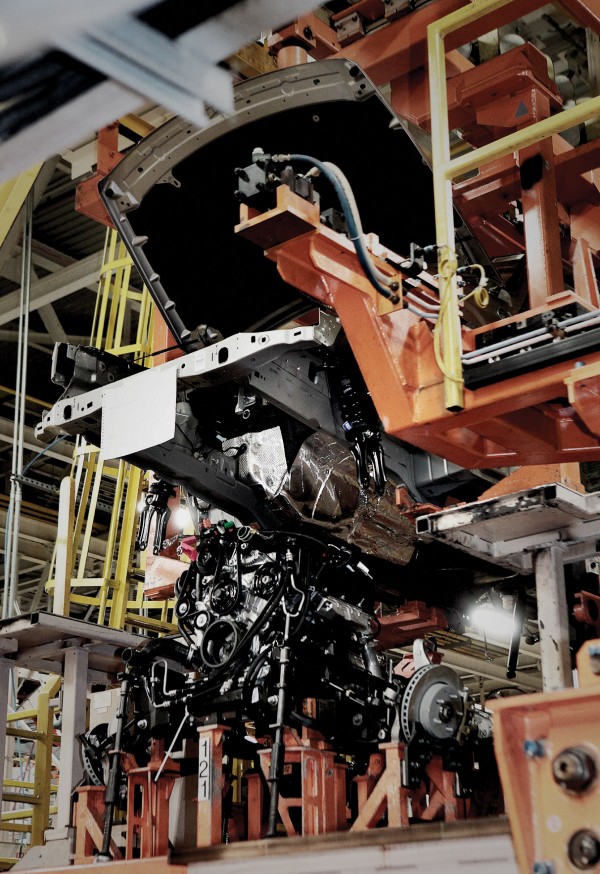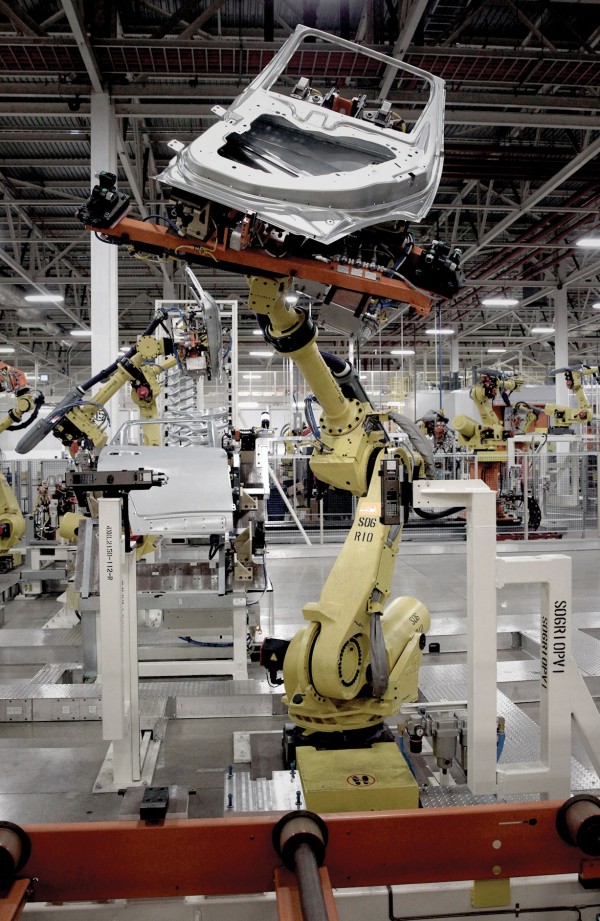
Ronald Shrewsbery II used to be the Robot Doctor. Now he’s known by the more bureaucratic-sounding title “WCM (World Class Manufacturing) Electrical Technical Specialist,” but he still doctors the robots. There are a thousand of these machines inside Ohio’s Toledo Assembly Complex, a 312-acre manufacturing leviathan dedicated to producing Jeeps. Huddles of one-armed robots hover over metal pieces, putting the parts together on their own. In the paint shop, robots spray coats of paint on Wrangler bodies.
The Toledo Assembly Complex is one of the most heavily automated car factories in the United States. It can extrude 500 cars in a shift, far more than the Cove, the old Jeep plant that was shut down in 2006. And the machines make the work easier. There used to be a lot more lifting, more pushing. Painters wore head-covering masks with air hoses, like old-time deep-sea divers. Welders in the body shop wrestled hanging guns. So you’d get people “with [bad] backs, arms, carpal tunnel, rotator cuffs,” Shrewsbery says. “It tore you up physically.” The new factory is as clean as an operating room in some spots, nothing like the darker, dirtier Cove. The cars rolling off the line are better, too.
Shrewsbery himself started in 1984 as a grunt-level assembly-line worker at the Cove. Then he bid on an opening to learn the electrician’s trade, and mastered it. His story is the fulfillment of a techno-optimist’s dream: automation gave him a chance to learn a new skill and earn a much better wage, just as it made the plant he works in more efficient, safer, and cleaner.
But even though the economy in Toledo is better than it has been in years, thanks in no small part to decisions by local authorities and industries to aggressively embrace new technologies, the changes are also creating an uncertain and worrisome future for many people. And they are expressing their worries at the ballot box.
Donald Trump’s campaign slogan “Make America great again” resonated with many in this part of the country. The heavily industrialized counties along Ohio’s western Lake Erie shore voted for Barack Obama twice. In 2016, most voted for Trump, flipping the state from the Democratic candidate to the Republican. Lucas County, where Toledo sits, did pick Hillary Clinton, but by much less than the 2:1 margins Obama had enjoyed.
In a recent paper, Oxford University researchers concluded that “Michigan, Wisconsin, and Pennsylvania would have swung in favor of Hillary Clinton if robot adoption had been 2 percent lower over the investigated period, leaving the Democrats with a majority in the Electoral College.” According to a 2017 study by the Brookings Institution, the Toledo metropolitan area is the most roboticized in the United States, with nine robots per 1,000 workers. There were 702 robots there in 2010. By 2015, there were 2,374. There are more now. In March, another study estimated that the state had lost 671,000 jobs to automation between 1967 and 2014, more than it lost to domestic competition (such as from right-to-work states, which restrict the power of unions) and foreign trade combined.

Joe Wilssens/fiat chrysler
But what makes the story in places like Toledo and the region around it hard for many politicians and even economists to understand is that the anxiety goes well beyond automation and the number of jobs. For many people, your job defines your life. The disruptions caused by robots and other technologies are deeply affecting the communities involved. These technological forces have joined many others—some cultural, some political—to create a generalized anguish that much is being lost. People have come to believe that they, their jobs, their communities, and the social contract that binds them to work and place and each other are under threat. And they’re not wrong.
Just a few days after I spoke to Shrewsbery, much of the Jeep complex shut down. Hundreds were laid off. The layoffs were temporary while the company retooled to make a new Jeep truck. But if the truck doesn’t sell and overall production volume drops at the complex, the good times will end. The robots, though, will still be working.
Good times for now
Local boosters argue that after a rough 30 years, Toledo is on its way back. The Jeep assembly plant is producing at full blast. A shiny new industrial park has opened for business on the old Cove site, practically underneath the one remaining smokestack, which was kept as a memorial. The old Libbey-Owens-Ford plant that made windshields for the Ford Model A and then for generations of cars over the next hundred years is rolling windshields off the line in Rossford, south across the Maumee River. Whirlpool, in the Sandusky County city of Clyde, is making thousands of washing machines per day. Toledo’s downtown is showing signs of rejuvenation.
But there’s no euphoria, no “Happy Days Are Here Again” vibe. “It’s almost too good right now,” Doris Herringshaw, commissioner for neighboring Wood County, told me. She and her colleagues are “wary” about the future: “We have that feeling of ‘Well, it’s great now. Let’s just hope we can keep it going that way.’”
Hard experience has taught Toledo. Drive along the avenue that skirts the north bank of the Maumee and you can see the grand mansions that testify to the prosperity of long-gone titans. Those titans turned Toledo into a cultural haven. Edward Libbey, a founder of Libbey Glass, provided the money to start the Toledo Art Museum, one of the nation’s finest.
But those mansions have boarded windows now. Many are fronted by dead lawns and crumbled sidewalks. The streets of the once-elite neighborhood are so potholed that residents say the new mayor won election by promising to fix them. (Congresswoman Marcy Kaptur and her neighbor are planning to use their own gravel and tar to fill a hole in front of their homes.) Despite the recent economic good news, too many downtown buildings that used to be offices or warehouses still stand empty and in disrepair.
During the last recession, Chrysler and GM (which makes transmissions in the area) declared bankruptcy. In 2010, unemployment topped out at nearly 14 percent. The population of the Toledo metropolitan area, which includes surrounding counties, has been declining for years.
Regional leaders believe one reason the area suffered so badly was a failure to adapt to technology. So after the recession they placed new emphasis on closing the “skills gap.” They wanted to create a “pipeline of people,” Herringshaw says, who could maintain robots, work with robots, program computerized machines. A basic high school diploma was no longer adequate.
The kids in Robert Golden’s Advanced Manufacturing Technologies program at Penta Career Center in Perrysburg are the beneficiaries of that effort. They work in a large, high-ceilinged space with short rows of drill presses and lathes, both manual and computer-controlled. A Fanuc LR Mate 200iD robot sits in a Plexiglas box awaiting student programmers and operators. Some of them have job offers before they even graduate. Golden, a genial man with cropped graying hair and safety glasses more or less permanently on his face, teaches skills that are in demand all over the region.
But what happens when the technology landscape that students are being trained to cultivate changes underneath their feet?
Few local leaders talk about artificial intelligence or smart robots. Gary F. Thompson, executive vice president and chief operating officer of Northwest Ohio Regional Growth Partnership, an economic development board, has of course heard of these new technologies and read a bit about them, but when he meets with mayors and other local leaders, nobody ever brings up what might happen if the next wave of automation turns the currently employed into expensive redundancies. Bruce Baumhower, president of Local 12 of the United Automobile Workers, serves on the partnership’s board. He can’t recall a time when the issue has been discussed.
When I traveled deep into rural Ohio to visit B-K Tool and Design in the village of Kalida, general manager Kevin Kahle told me his customers don’t talk about AI either. It does not inform his business planning. That may seem odd, since B-K is one of the region’s largest businesses helping manufacturers from Honda to small independents design and install robotic systems. But he’s so busy adding new employees and trying to keep up with demand that there’s no time to noodle over something as conceptually fuzzy as AI.
Such technologies still seem too esoteric and vague to influence the political or social structure of communities, especially when nobody can say for sure whether the labor market will change significantly. Meanwhile, the region has immediate needs. Potholes need filling, downtown needs rehabbing, and students need training to operate lathes in order to get the jobs on offer right now.
Some Toledo-area leaders might realize that a technological meteor is headed their way. But what are they supposed to do about something so unpredictable in its details? So they stress “lifelong learning.” From the junior high kids in the robotics camp to the factory-floor employee, they all have to turn their lives into one long hustle to keep their heads above the incoming tide and whatever it might wash in.
What Silicon Valley doesn’t understand
Rickey slammed his hand down on the bar at Andy’s Bar and Grill and said, “I couldn’t believe it!” He works at an auto-related factory in Wood County. When he and his buddy, who sat next to him drinking a post-shift beer, started at the plant, they had about 1,600 fellow workers, they said. Now there are about 600.

Jeff Kowalsky | Getty Images
But that’s not what had Rickey so agitated. “I mean, that shook me,” he said of the 2016 election night.
Rickey is an African-American man who doesn’t like to attribute anything to racism unless it’s so obvious you’d have to be blind and deaf not to perceive it. Trump’s campaign slogan rang hollow to him. “‘Great again’?!” he shouted. “What’s that mean? Wasn’t so great for people who look like me!” But he “couldn’t believe how many people voted for Trump.”
Rickey being Rickey, he thought maybe the Trump phenomenon wasn’t so much about race, exactly. When somebody in a red MAGA hat would talk to him, they’d talk about jobs. Rickey would point out that President Obama and the Democrats in Congress had favored bailing out Chrysler and GM, but he never got very far with that argument. The bailouts came almost a decade ago. All over again, people in the plant seemed so insecure about wages, retirement, jobs.
“We used to laugh at the robots,” Rickey’s buddy said. “When they first came in, they were so slow. We would sorta hurry and outproduce them. But one of the lines was about 18 people, and now they can run it with, like, five.”
Rickey and his friend were echoing, almost word for word, two other men with whom I’d shared one-dollar beers in the Agenda Sports Bar, not far from the Toledo Assembly Complex. Both 30-year men who’d started at the Cove, they now worked at the complex. Both referred to management and agreed that “they want us out of there.” One said, “If they could replace us with robots, they would. They doin’ it faster and faster. You ain’t gonna fool me! … They gonna replace us as fast as they can.” Both also agreed that, despite the recommendation of UAW Local 12, “lots of people in our plant voted for Trump.”
“Look, man,” Rickey’s friend said. “I’m a dumb guy. I am! I had a learning disability when I was in school. But I could do factory work. Factory work is what we did. Now robots do that job. What happens to people like me? People in the plant thinkin’ somebody’s gonna save ’em, like Trump. There ain’t nobody gonna save ’em.”
Rickey looked at me and said he tells his own children that if they wind up working in the plant, “then I failed as a father.”
Every person I talked to in the Toledo region said technology was as unstoppable as the sunrise. The inevitability of it, and the uncertainty about what it would mean, weighed on them like lead blankets. Of the two men in the Agenda, one’s grandfather and father had worked for Jeep. The other’s father did. But legacy didn’t mean anything anymore. You couldn’t count on much for very long.
Kaptur listens to the people in her district and hears the same thing between the lines. “People feel very much alone,” she says. “Vulnerable.” Her voters have lived through globalized trade, outsourcing, recession, and the coming of robots. Soon it’ll be AI. Meanwhile, defined pension plans are gone in favor of 401(k)s. More companies, like Fiat Chrysler, use more temp workers. New workers sign on to lower wage tiers. A working draft of the World Bank’s World Development Report advised governments that “rapid changes to the nature of work put a premium on flexibility for firms to adjust their workforce, but also for those workers who benefit from more dynamic labor markets”—a fancy way of saying labor is disposable.
The effects are felt far beyond the jobs themselves. “Tribes of affection matter,” Kaptur says. “Whether it’s work-related, or a vets’ organization, or church, neighborhood, neighborhood businesses—they’re all evaporating. It’s the disappearance of everything they’ve worked for. Their identity, really.”
This is what Silicon Valley promoters of salves like universal basic income fail to understand. The engineers and programmers of the new machines seem to think they can buy off the displaced with a promise of cash. But many people don’t work for money, not really. They need the money, and they want the money, but money alone isn’t why anybody worked 40 years in the Cove. They stood on the line and welded or painted or bolted because they were auto workers in a country in which what you do is who you are, just as Shrewsbery is the Robot Doctor. They could look at a Wrangler, or a glass windshield, or a Whirlpool washer, and say “I made that.”
Probably nobody voted for Trump just because of technology. But when people feel powerless, they’ll gravitate toward any object, person, or belief they think might return some autonomy to them, or help them preserve what they fear they’re losing.
“Nothing’s permanent,” Rickey told me. “We’re in a transitional stage, and it scares me.”
A few miles away from Andy’s Bar and Grill, and adjacent to Interstate 75, a gigantic Bass Pro Shops Outdoor World built to resemble an enormous two-story timbered lodge was crowded with adults and families. The store offered every imaginable kind of fishing rod and reel, a mammoth aquarium stocked with freshwater game fish, deer heads mounted along a balcony, and clothing to suit almost any kind of expedition.
On the lower level, customers could shop in a separate “general store.” A “fudge shop” tempted boys and girls of all ages. It was a village Main Street from a nostalgic dream of an America that no longer exists but feels ever more seductive as American life becomes increasingly unpredictable and unfair.
Brian Alexander is the author of Glass House: The 1% Economy and the Shattering of the All-American Town.



